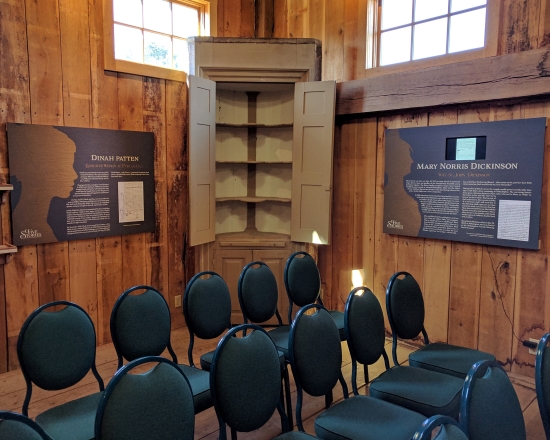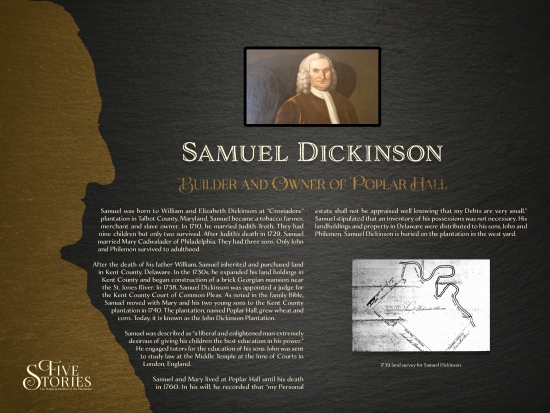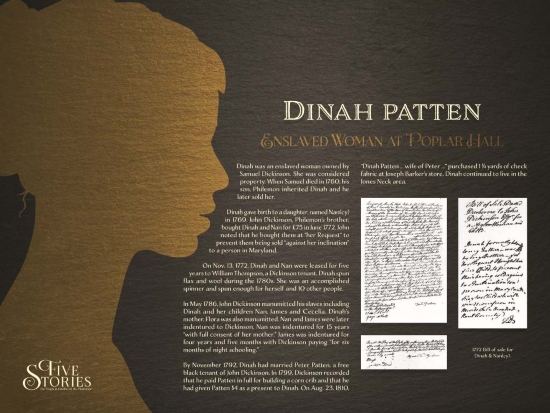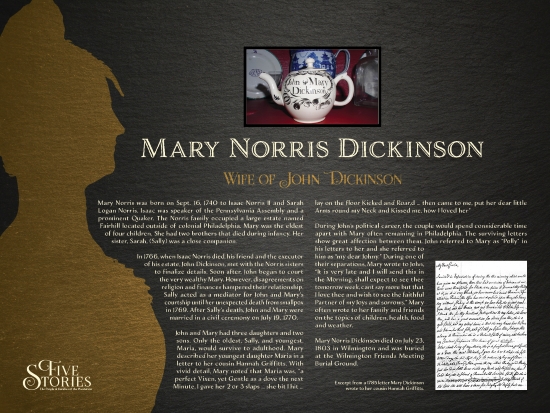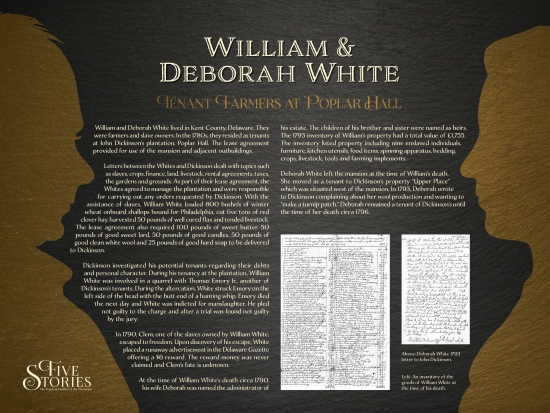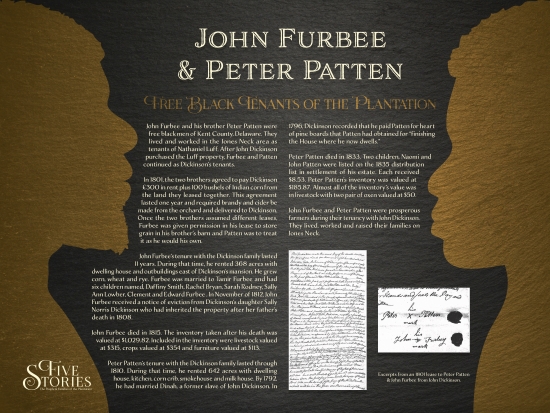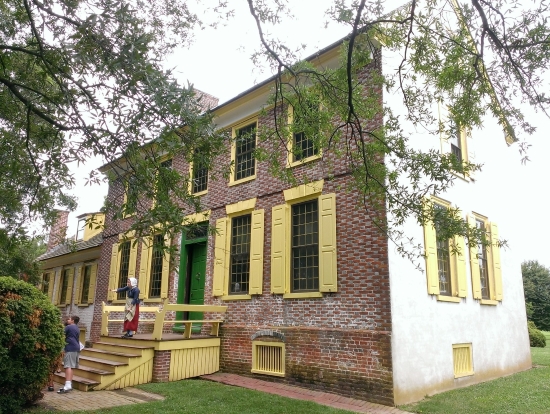‘Five Stories’ explores the lives of people who lived and worked at the John Dickinson Plantation
The John Dickinson Plantation, located at 340 Kitts Hummock Road in Dover, Del., is currently featuring “Five Stories,” a series of descriptive panels that explore the lives of a variety of people who lived and worked on the farm of American patriot John Dickinson.
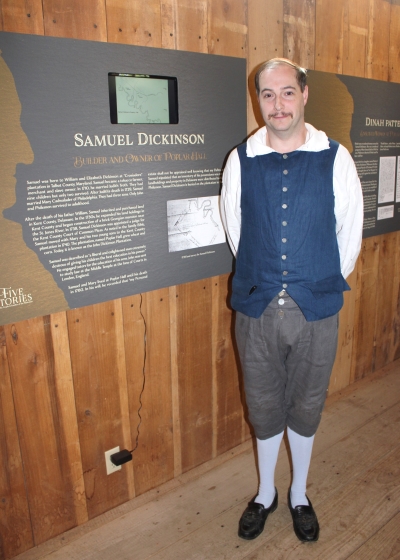
Between 1740 when Samuel Dickinson, a wealthy Quaker tobacco planter and merchant of Talbot County, Md., moved his family to the site on Jones Neck, southeast of Dover, Del., to John Dickinson’s death in 1808, more than 200 people were deeply connected to the plantation including Dickinson family members, tenant farmers, tradesmen, free Blacks, indentured servants and enslaved individuals. “Five Stories” looks to bring some of their experiences back to life.
During its first iteration, which opened in February 2017, “Five Stories” provides information on the lives of family patriarch Samuel Dickinson; Dinah, an enslaved woman owned by Samuel who was later manumitted by John Dickinson; Mary Norris Dickinson, John’s wife; William and Deborah White, tenant farmers at the site; and John Furbee and his brother Peter Patten, free-Black men who rented farmland from John Dickinson. Following are images of the five descriptive panels:
Aside from the Dickinson family itself, information on the people associated with the site is extremely difficult to find. However, thanks to painstaking research by historians, archaeologists and Division of Historical and Cultural Affairs staff members; as well as scholarship conducted under the auspices of the Friends of the John Dickinson Mansion, details about the lives of the plantation’s people have been mined from a variety of places including, among others, the Delaware Public Archives, Delaware Historical Society, University of Delaware and the Historical Society of Pennsylvania. While important information has been gleaned from likely sources such as maps, letters and diaries, it has also been found in more mundane places such as probate inventory, account-book records and bills of sale. As additional information is uncovered through research, new panels will be created that tell the stories of other people who lived and worked at the plantation.
The installation of “Five Stories” is the latest in a series of improvements that have taken place at the plantation’s visitor center since 2010. Originally constructed in the late 1980s, the visitor center is located in a replicated 18th-century-style barn whose interior is infused with the scent of fragrant, undressed wood. Improvements that have taken place in recent years include extensions to the right- and rear-sections of the building, the addition of several windows, upgrades to the restrooms and additional steps that have brought the facility more fully into compliance with the Americans with Disabilities Act.
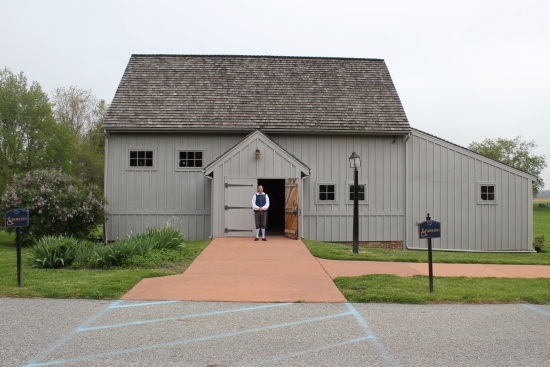
The visitor center is open Wednesdays through Saturdays from 10 a.m. to 4 p.m. Guided tours of the mansion are available from Thursdays through Saturdays at 10:30 a.m., 11:30 a.m. 1:30 p.m., 2:30 p.m., and 3:30 p.m. The grounds of the John Dickinson Plantation are open for outdoor visitation on Tuesdays through Saturdays from 10 a.m. to 4 p.m. For additional information, call 302-739-3277.
The John Dickinson Plantation, Delaware’s first National Historic Landmark, was the boyhood home of John Dickinson, known as the “Penman of the Revolution” and a framer and signer of the U.S. Constitution. Dickinson wrote about freedom and liberty for all while continuing to hold human beings in bondage. The plantation shares the stories of the Dickinsons; the tenant farmers; the trades people; the indentured servants; the free and enslaved people; and the families who lived, labored and died on the land. Administered by the Delaware Division of Historical and Cultural Affairs, the museum is a partner site in the First State National Historical Park.
Go to the following for a full listing of exhibits and displays at the museums of the State of Delaware.
Go to the following for a comprehensive, long-term calendar of events sponsored by the Division of Historical and Cultural Affairs.



